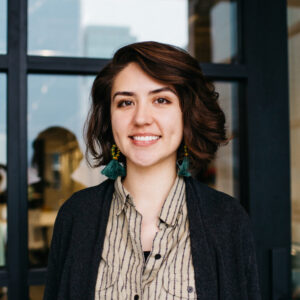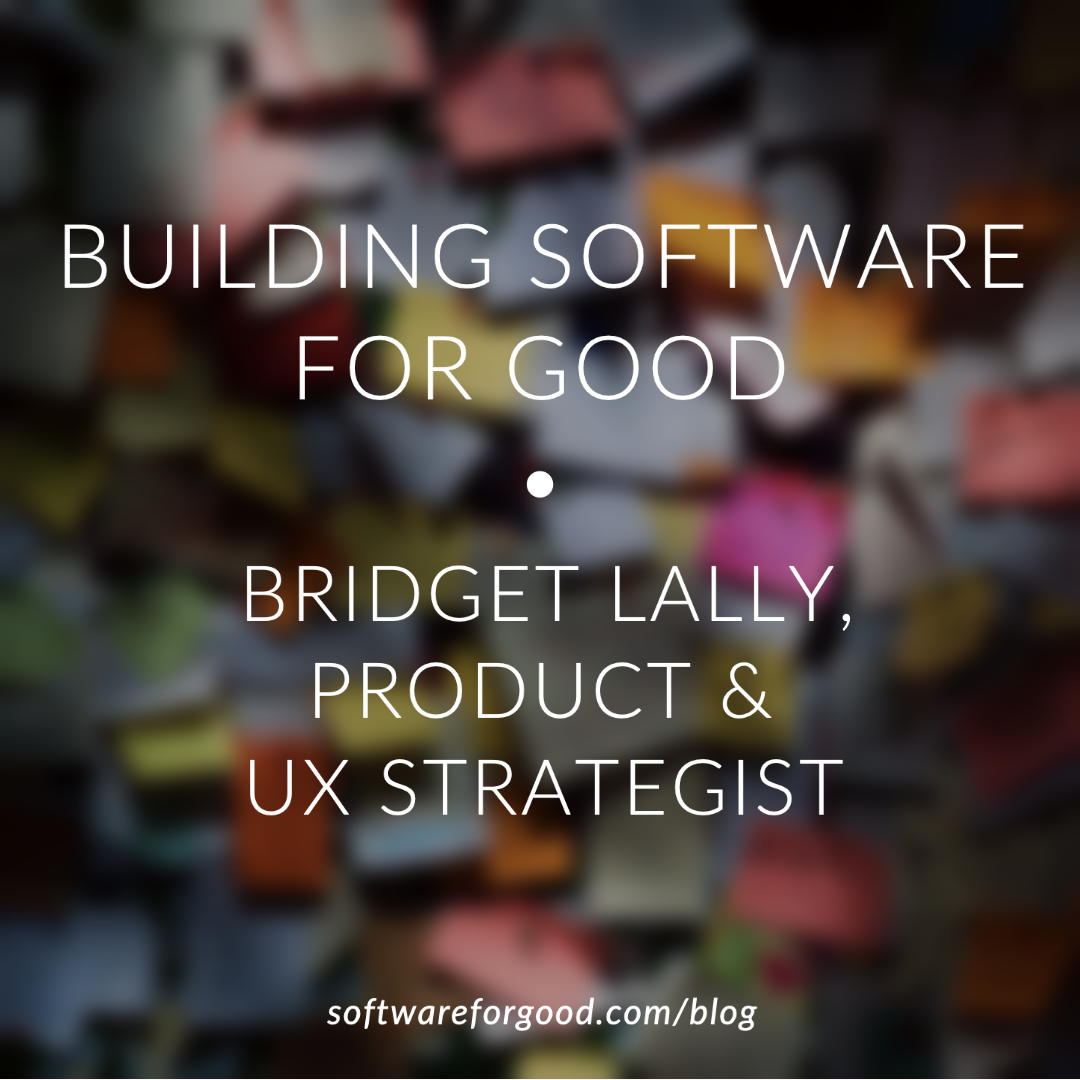No two projects at Software for Good are alike — we’re always learning and adapting to the needs of our mission-driven clients. As we continue to expand our user experience (UX) and product strategy offerings, team member Bridget Lally recently moved into the role of Product & UX Strategist.
We talked about what that change means and how her work connects to building software for good.

You’ve been with Software for Good for a little over a year, but recently updated your role and title. What does that mean for your responsibilities and day-to-day work?
User experience can take on a lot of different forms, so it can mean things like creating wireframes for a client, creating prototypes and testing them with end users, doing some initial research work like surveying users, or even conducting interviews with users before we start building anything. A lot of my work with clients will also be about taking all of that work and making sure we’re building the most impactful thing, usually for the least amount of money, because our clients tend to be nonprofits and social enterprises who can’t afford to spend a lot. So my contribution will be to work with clients to figure out how we can build something impactful with the resources they have.
On the product side of things, it’s helping clients build out backlogs and roadmaps for development, and having that be a continuous, collaborative process that I’m doing with clients to say, okay, this is the roadmap that is going to serve their needs.
How does your job connect to what we do for clients?
I’m still going to be working with clients, but before my role was definitely focused a lot more on project management and account management work, and now a lot of my communications with clients are going to be about the user experience we’re trying to build with them. It’s going to be about the overall product goal we’re working towards, and so in my opinion it’ll be a deeper relationship because we’re going to be making decisions together and not just setting up timelines and milestones.
It’s going to be about holding space and influencing to make sure users’ voices are heard throughout the building process.
How does your job connect to building “software for good”?
There’s a lot of times when I think people assume that they know what to build, or that they have all of the information to build something without considering groups that might not be in their direct view. The responsibility of UX in general is to ask, “Are we considering all of the people that could be impacted by this work?” and “Are we considering all of the ramifications of what we’re trying to build?”
I see part of my role as making sure our products are accessible and available to marginalized communities. Most of our clients are already thinking of doing stuff for good. I don’t doubt that that’s already on their mind, so making sure that we’re maximizing the good that they’re already doing in the world.
What’s your favorite part of your job?
I love hearing individuals’ perspective on things. One of the main reasons I got into UX was that right after college, I did this “how to figure out what you want to do with your life” bootcamp. They gave us a small project that made us go out and explore how to redesign how people experience coffee, because it was loosely affiliated with Starbucks in Seattle. We went out to a bunch of coffee shops and asked people questions like, “Why are you sitting in this coffee shop? What do you like about coffee shops?” and then synthesized all of that information into a proposal for how to make coffee shops more of a third place for people, a space outside of work and home. So that taught me that I really enjoy talking to people about what they’re experiencing and what they want, and trying to build that into the product we create. I even love doing that with our team internally.
So the empathy aspect is my favorite. Usually, in any story, there’s this “aha moment” where you think, okay, I know what direction I’m going and what I need to build.
What’s been your favorite Software for Good project you’ve worked on so far?
One of the recent projects that has been really fun is our project with Forest Carbon Works. Because they have so many different types of users and a really long process that we had to make simple and straightforward, that felt really exciting. And because the organization as a whole is trying to reduce the carbon footprint of society, it was a really good combination of something that was exciting to work on and has a good impact on the earth.
The other project that comes to mind is the City of Saint Paul, because I’m getting a chance to effect change on a local level and work on software that will eventually impact hundreds of thousands of residents.
What do you wish more people understood about UX and product strategy work?
I wish more people gave it a chance, because I think sometimes we come across clients with limited time or money to spend on a project, and they assume we can’t spend time on user experience or product strategy work. We’ve found that when you take the time upfront to do that work, what you’re building is going to be more impactful and better fit within a certain budget.
What excites you about the field of UX and product strategy? Are there trends you’re excited about?
Accessibility is a trend I think is exciting. Civic tech — there are so many great organizations like Code for America or Data for Democracy that do really great stuff with open source tools and projects.
Maybe this isn’t UX-related or a trend, but a general thing that excites me is the idea of how to become a good listener. One way I’ve been learning to do that is through nonviolent communication. The exact framework of nonviolent communication, I’ve been working on for about a year now and really trying to practice it intentionally. It’s basically the idea of understanding emotions that are happening and identifying the underlying needs. It’s something you can practice on yourself and other people, and ultimately the goal is to create space to allow whoever you’re communicating with to be themselves, which I think helps with the empathy piece of UX work.
What kinds of projects are you hoping to work on in 2020?
Continuing a lot of the City of Saint Paul work that we’ve been doing over the last couple years. We’re also kicking off a project with Shelter Animals Count, which hopefully will allow more shelters to get access to data so they’re making good decisions for the animals they’re helping.
Anything else you’d like to add?
It’s great being in an environment that helps me grow as a UX and product person!

